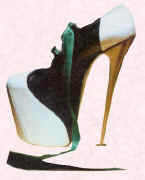One of the greatest restrictions placed on women has been corsetry. Severe lacing restricts movement and can damage internal organs and impair health. Female emancipators of the early 20th century used pictures which showed the position of the female internal organs with and without corsetry. Pictures of deformed rib cages were also used illustrate how breathing was impaired. They used the evidence to support their arguments for condemning the corset. There is considerable thought that such images of wasp waist were enhanced by artistic licence.
 Small waists did exist, but were usually on young girls and needed 'training'. Today when women take to corsets it can take about 2 years to achieve a gradually smaller waist using lacing methods. Goths are very fond of corsets in their fashion style.
Small waists did exist, but were usually on young girls and needed 'training'. Today when women take to corsets it can take about 2 years to achieve a gradually smaller waist using lacing methods. Goths are very fond of corsets in their fashion style.
Typical images used in medical books and which suggested a woman's internal organs before and after restraining in tight corsetry in the Victorian era. Please note that even the Victorians were capable of manipulating pictures to their own end if it served a purpose.
Recent medical examinations of females corseted today in actual Victorian corsets show how the women had no energy and lacked breath when given lung tests. Once the corset was undone the women felt energised again.
The test is not a fair test as women did not simply lace immediately to a 16 inch waist, they trained the waist over a period of years. Over 2 years a 22 inch waist can be gradually reduced to a handspan by gradual increments of the lacing. It would take about a year of not wearing a corset for the internal organs to settle back to the natural position. But back they would go.
 Small waists did exist, but were usually on young girls and needed 'training'. Today when women take to corsets it can take about 2 years to achieve a gradually smaller waist using lacing methods. Goths are very fond of corsets in their fashion style.
Small waists did exist, but were usually on young girls and needed 'training'. Today when women take to corsets it can take about 2 years to achieve a gradually smaller waist using lacing methods. Goths are very fond of corsets in their fashion style.Right - The unnatural hourglass figure.
Typical images used in medical books and which suggested a woman's internal organs before and after restraining in tight corsetry in the Victorian era. Please note that even the Victorians were capable of manipulating pictures to their own end if it served a purpose.
Recent medical examinations of females corseted today in actual Victorian corsets show how the women had no energy and lacked breath when given lung tests. Once the corset was undone the women felt energised again.
The test is not a fair test as women did not simply lace immediately to a 16 inch waist, they trained the waist over a period of years. Over 2 years a 22 inch waist can be gradually reduced to a handspan by gradual increments of the lacing. It would take about a year of not wearing a corset for the internal organs to settle back to the natural position. But back they would go.








